Silver Valley Ponies

© Janet Lane, 2024. Image: Wild ponies in the Petford Range/ Silver Valley area, supplied by Simone McArdle.
The Silver Ponies of Silver Valley. We acknowledge the Traditional Owners.
Beautiful Silver Valley in the Atherton Tablelands – and surrounding country extending from Petford Range to Herberton Range, Mt Ruby station, Innot Creek area, and The Bluff Forest Reserve, has some beautiful wild ponies. Rainforest, mountain ranges folding forever, fertile plains, hidden mine shafts, wild rivers – an idyllic background for these exquisite little equines.


The ponies have a fabulous history of top-class breeding from the horse days and even more exciting – and appropriate for their area – some have the rare silver gene.
The colour silver bay was often called taffy in the times before we knew how to identify and accurately describe colour genetics. Sometimes called silver. This old colour has vanished from many breeds now but it’s a good sign in Walers (stallion Cobba for example) as it often shows old blood and good genetic diversity.
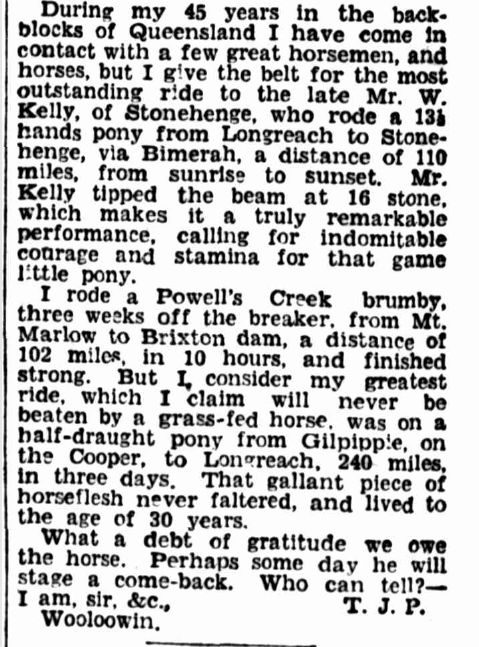
Pony breeding was huge in this area in the horse days – the lodestone of pony breeding in Queensland. Many people made their living droving horses and ponies to sales: both Australians sales and the overseas trade. Many places concentrated on horses and ponies rather than other livestock. Great pride was taken in them. As well as sale prices, various shows and gymkhanas were the place to show off your stock, as well as driving them in harness and using them to muster and drove stock in country that was often steep and heavily forested, thus suited to sure footed ponies.
Interesting to note the roan colouring in photos from Herberton Show, as this may still be around today.
Image: Courier Mail, 1934


Unfortunately, most of the photos of ponies we can find in the Archives are in old newspaper articles from the Herberton Show, and are too blurry to reproduce in this post. The best photos to be found are of the working horses from the area, especially timber carting. They also had good coach horses in the greater area, and butter factories with horses delivering milk, cream etc. There are a lot of greys to be seen in some teams just so few clear photos of them but wouldn’t surprise me to see greys in the wild horses still roaming.
Irvinebank, is a mining area once known for its immensely tough work horses and ponies that were sure footed and able to tote big weights over extreme country is in the area. Various other mines saw a lot of tough horses and ponies used – bred and grazed at large as mine stock were, some staying free forever when miners departed for other fields. Mining continues in the area with one massive tin mine still operating.
The timber industry also employed many hardy horses, the rainforest logs were enormous, and the country tough going. Images of log carting in the Atherton Tablelands below from State Library of Queensland.

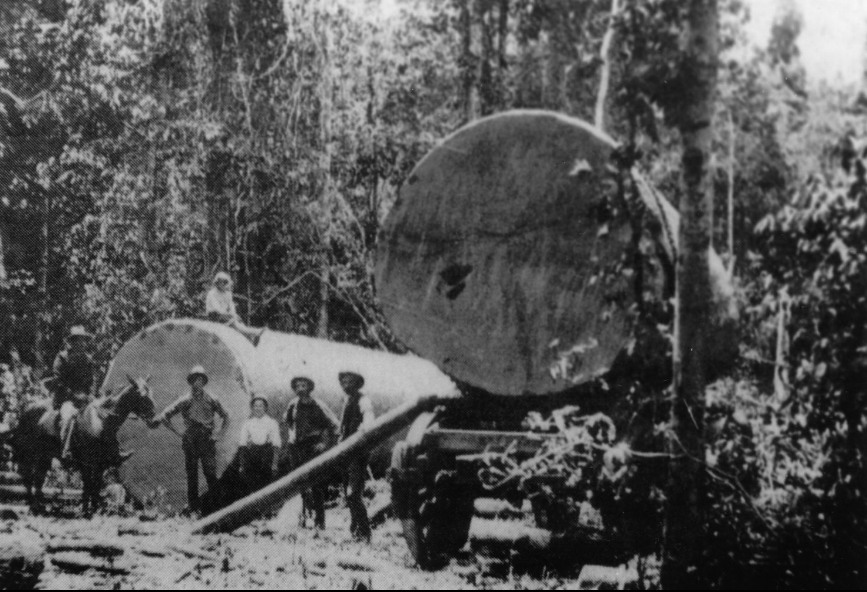




From Angel Tanner who started the ball rolling on following these ponies up, March 2024:
“So these ponies were between the Petford Range and the back country of Silver Valley. The mobs occasionally would wander into Mount Ruby station where I worked at the time (178,000-hectare station that fronted Silver Valley Road and backed onto the Herberton range). Interesting mention of silver bays (around Goldsborough and Fraser coast: see pony Beau), as there was silver in the mobs. None of them ever any bigger than 13.3 with most not exceeding 13 at all, 12-13 was the most common.

This is our BJ ‘Billy Jean‘ one of the Silver Valley FNQ ponies she wandered herself into one of the one-way cattle traps and was brought in with the cattle. Had a horrible start from the stockmen (hence the scar on her face) but turned out to be one of the most reliable, go anywhere do anything ponies I’ve ever had. I always described her as having a million faces as her look changed so dramatically between winter and summer and every season in between, she could look like a completely different pony one day to the next.



She was very well put together, could be ridden with just a neck rope, in halter or in bridle, she went in harness – 2 and 4 wheel. She was only ever ridden by myself or my kids, never did anyone else ever hop on her. (Tons of people used to ask and I’d say ‘if you can catch her you can ride her’ I knew full well she would never be caught by anyone: very very much MY pony, but if I handed the reins to one of my kids she tolerated them.)



The pony mobs up there were never any bigger then 13 hand, small, quite attractive ponies with good strong legs. BJ actually saved my life in the tablelands, when she was going well under saddle I took her out on a big ride in the bush and got lost, came across a pack of wild dogs and she spooked, I fell, she took off, my collar bone was broken and I had blood pouring out of my head. I grabbed a tree branch and was whacking the ground to keep the dogs away, BJ came thundering back (felt like I was there for a good half hour but in reality it was probably only minutes before she came back) she circled me striking and kicking at the dogs, bit one in the middle of its back and literally picked it up and threw it, I scrambled back up on her and she galloped all the way home. I know it sounds dramatic but if she hadn’t come back I would be dead and she had no reason to come back.

The scar on her face was from wild dogs, her whole face was ripped open when she was caught in the cattle trap. It’s really an exceptional story that shows the depth of bond these wild caught horses make with their humans. She faced her own trauma to come back for me.”
Images of Billy Jean and her story supplied by Angel, just wonderful to have this personal history of one of these outstanding ponies, thank you for sharing them with us.
Like most areas, shooting to reduce the wild population has been done in a heavy-handed manner, and continues; so the population is not only controlled but is far fewer than the country could easily support. Thus there isn’t an issue with damage. Nonetheless fortunately they seem to have survived over this huge area in enough numbers to prevent inbreeding, although of course DNA tests will tell us all and will be of huge interest regarding their background. As camera herds a balanced population would be a boon. As a source of safe children’s ponies too.
The Tablelands were first explored by colonials in 1875. Tin and gold were found which opened it up. There was an extensive Aboriginal population who’d lived for thousands of years in the forests. The usually tragic colonial dislocation and deaths, but many better stories of the people surviving, remaining on country; some employed on the new farmlands and becoming top class horse breakers and drovers.
Image: Native huts in Trinity Bay in the 1870’s, Cairns Museum

Welsh ponies, Timors, Shetlands, Roadsters, Hackneys, Thoroughbreds, draughts (most being Suffolk Punch) all went into the mix. Stock movement reports in the papers are full of mobs of ponies and horses being taken out of the area for sale, in all directions.

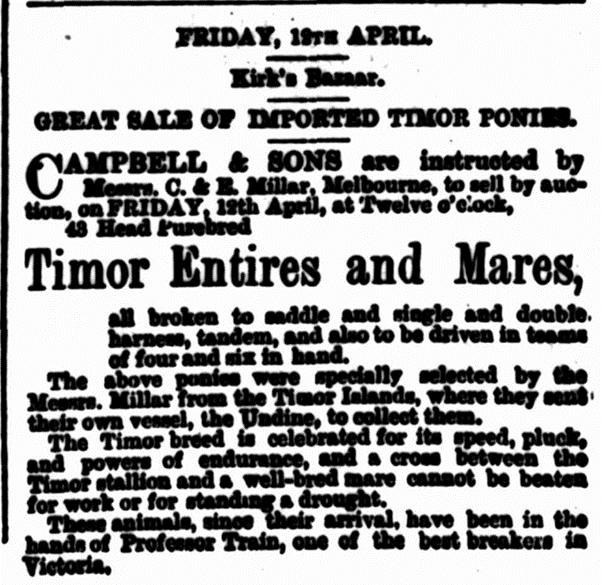
Many Timor Ponies were bought by those in the greater Silver Valley area.
For example, a Timor stallion had pride of place in a mob of mares on a property on the upper Herbert River in the early twentieth century, being admired by a traveller through there.
Image: The Queenslander, 6th April, 1889
There were several good Welsh stallions standing in the Atherton area too, and ponies and horses droved through to Cairns, Charters Towers and other places for sale.
Notably: Mount Garnet, Woodleigh Station, St Ronans, Meadowbank, Cashmere, Mt Ruby and Gunnawarra bred top class ponies and horses.
Image: Cairns Post, 14th August 1911
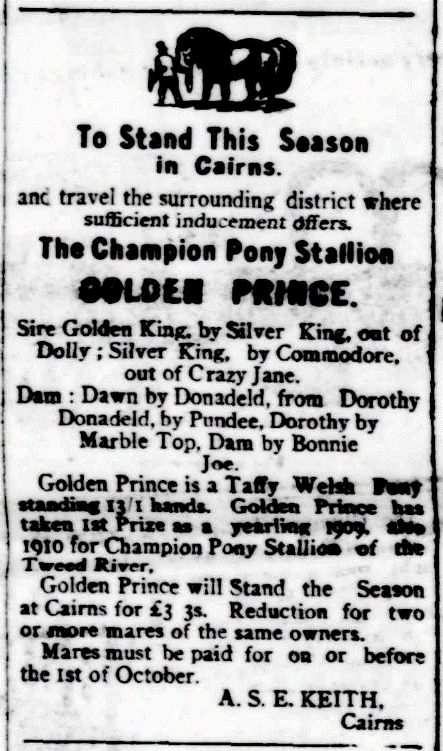
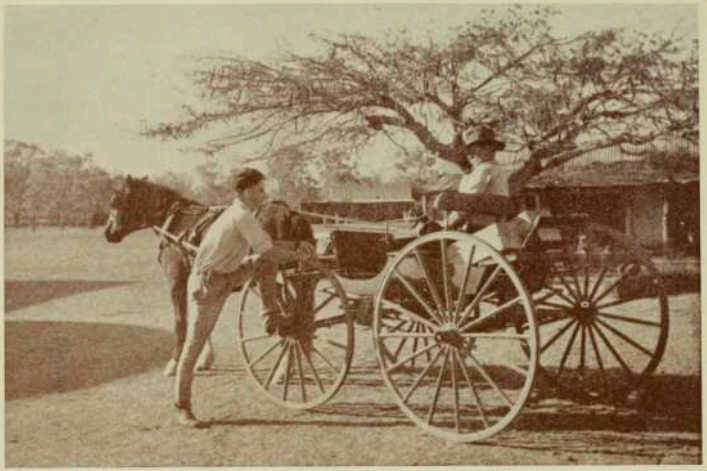
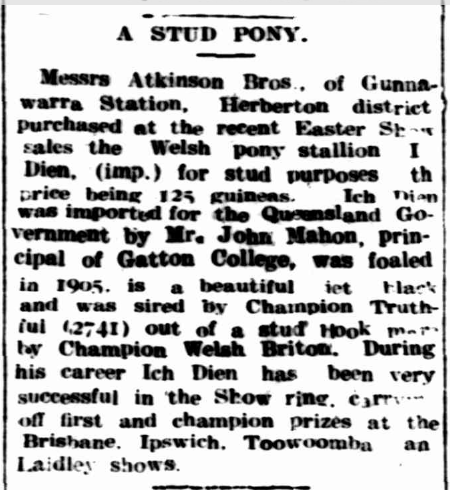
Image: Cairns Post, 5th May 1911
The name Ich Dien is the motto under the Prince of Wales’ feathers. He is a finely built Welsh Cob, 13.2hh.
Most Cobs had bone, but he was quite fine, as racing pony trotters were fashionable in Britain and here. He was black.
Woodleigh – where Wild River and Millstream meet to form the Herbert River – was set up by J. Garbutt, who had an outstanding horse of the Bay Middleton breed and bred horses and cattle there for 10 years; he moved onto Tirrabella and kept up his horse breeding. In the 1880’s Woodleigh was bought by the Grant brothers, James and Wallace. Then joined by their father Franklin. Franklin then took up Campsbourne on the Herbert River, renaming it Mandalee, the local Aboriginal word for the mighty fig trees which grew there. The Grants bred top racehorses and also draughts, winning many show prizes with both and selling many good work horses. Franklin Grant kept Mandalee until he died in 1926 when it passed to his son James.
In the mid 1890’s Munro, Gordon & Co bought Woodleigh, then about 1914 the Williams bought it, James Henry (Jack ) Williams managed it. All were great horsemen and pony and horse breeders, Jack the best of all. Jack Williams passed away in 1943, he’d managed Woodleigh for 29 years.
Jack bred many good horses, also rode at picnic races and steeplechases and shows. He always had about 8 or 9 racehorses int raining on the station and took them to Cairns to race. He’d been a horse trader for some time before managing the station. He’d also run a horse and mule packing business from Mareeba and Cadwell to Mount Garnet, and from 1909 to 1911 a long mail service from Mount Garnet to many other places.
On Woodleigh he also bred remounts for sale to India and New Guinea. The great trader J.S. Love even came out to buy his horses, and Love was super fussy and super shrewd. He paid top price!
St Ronans was famous for the SID brand on their ponies which sold far and wide. Duchess was a famous jumping pony they bred. It was owned by the D’Arcys, they sold out to Stewart & Thomas in the 1920’s.
Article about St. Ronans from North Queensland Register, 23 October 1895

Jeff Guest of Petford Range, the famous horseman who also saves Aboriginal youth and helps them learn horse skills, loves the brumbies of the area and saves some of those too. Jeff is now in his 90’s and still gently breaking!
This is an ongoing project finding and identifying these ponies. Any help, particularly photos, would be much appreciated thanks.